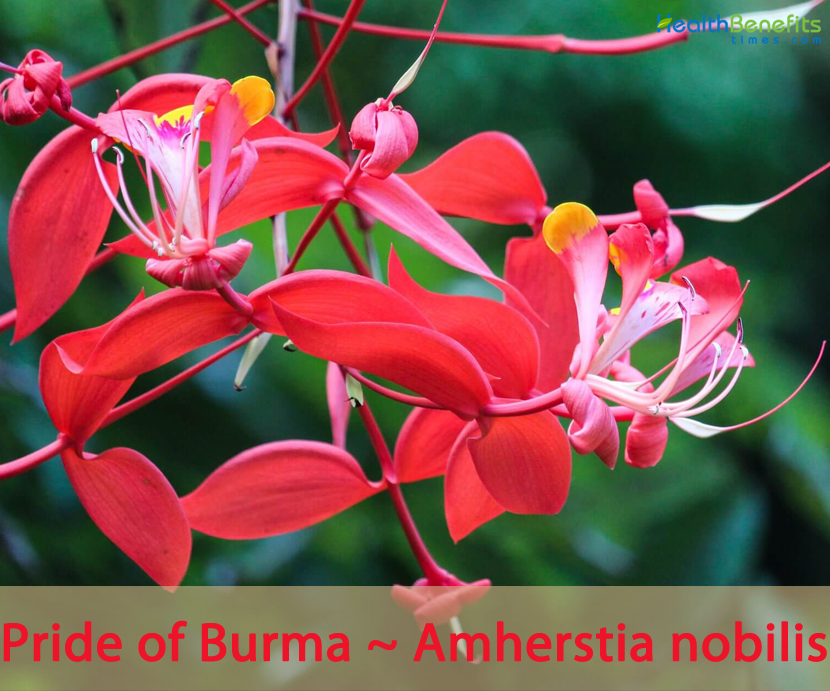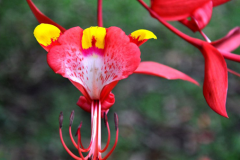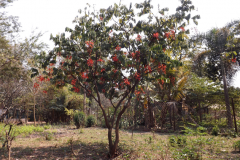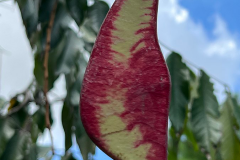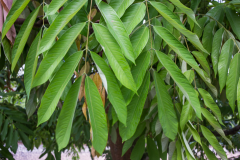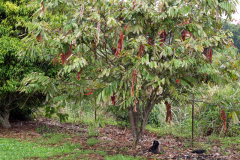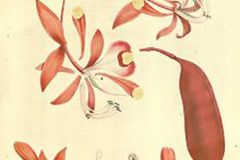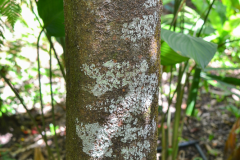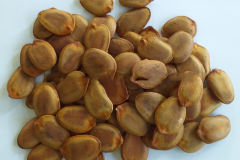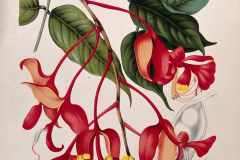| Pride of Burma Quick Facts | |
|---|---|
| Name: | Pride of Burma |
| Scientific Name: | Amherstia nobilis |
| Origin | Myanmar (Burma) |
| Colors | Vibrant red color when young |
| Shapes | Flattened seedpods oblong in shape, woody and can measure between 11-20 cm in length and 4-5 cm in width |
| Name | Pride of Burma |
|---|---|
| Scientific Name | Amherstia nobilis |
| Native | Temperate southeast Asia and is closely associated with the country of Myanmar (Burma). Found in southern Myanmar, in Kayin and Taninthayi |
| Common Names | Queen of Flowering Trees, Pride of burma, Orchid Tree, Lady Amherst’s Pheasant, Noble Amherstia, Tree of heaven, Queen of flowers, Burma flower, Shokrey |
| Name in Other Languages | Bengali: Urbaśī (উর্বশী ) Burmese: Saw k kyee (သော်ကကြီး), Toha thoka, saw k pain (သော်ကပင် ) Chinese: Yingluo mu (瓔珞木), Zhíwù zhòng wén míng: Yīngluò mù (植物中文名: 璎珞木 ) Croatian: Toha drvo English: Orchid tree, Pride of Burma, Queen of flowering trees, Tree of Heaven, flame amherstia, Amherstia Finnish: Burmanylpeys French: Arbre à orchidées, Arbre du paradis, Arbre orchidée German: Stolz von Burma, Tohabaum Hindi: Sita ashok (सिता अशोक) Indonesia: Bunga Saputangan Japanese: Yōraku boku (ヨウラクボク) Malayalam: Shimsha pavuksham (ശിംശപാവൃക്ഷം), Shimshipavrisham, Shimshipa viruksham Malaysia: Bunga Amhestia Marathi: Urvaśī (vanaspatī) (उर्वशी (वनस्पती)) Myanmar: Thawka, Thawka-gyi Persian: گل سرسبد برمه Philippines: Amherstia Portuguese: Orgulho de Burma Russian: Amkherstiia blagorodnaia (Амхерстия благородная) Sanskrit: Urbasi Spanish: Árbol de las orquídeas, Árbol orquídea, Orgullo de Birmania Swedish: Amherstia Tamil: Urvasi maram Thai: A-sòhk rá-yáa (อโศกระย้า), T̂n s̄ok raŷā (ต้น โสกระย้า), Dtôn-sŏh-grà-yáa, Sŏh-grà-yáa (โสกระย้า), Sòhk lĕuang (โสก เหลือง), Sòhk kăao (โสก ขาว), Sòhk sà bpan, (โสกสะปัน), Sòhk sôm sùk (โสกส้มสุข) |
| Plant Growth Habit | Medium-size tropical evergreen tree |
| Growing Climates | Lowland, monsoon teak forest on calcareous soil |
| Soil | Prefers a moist, humus-rich, fertile soil in a humid, sunny to partially shaded position |
| Plant Size | Typically 10 to 15 m (30 to 50 ft) tall |
| Crown | Rounded crown, gentle weeping branches |
| Trunk | Slender trunk, smooth bark which is light brown to grey |
| Leaf | Leaves are compound, with 6 to 8 large leaflets, broadly oblong and pallid underneath. Leaves when young are reddish purple; large mature leaves have white undersides |
| Flowering season | February to May |
| Flower | Each inflorescence contains around 20-26 flowers, each with five petals. Among the petals, two are very small while the remaining three are unequal in size. The petals are also crimson in color, with the two medium-sized petals having yellow tips |
| Fruit Shape & Size | Flattened seedpods oblong in shape, woody and can measure between 11-20 cm in length and 4-5 cm in width |
| Fruit Color | Vibrant red color when young |
| Propagation | By seed, stem cuttings of greenwood, and air layering |
| Plant Parts Used | Leaves |
| Culinary Uses |
|
Plant Description
The Pride of Burma is a medium-sized tropical evergreen tree that grows between 30 and 50 feet tall when it is grown in a garden. But in some places, it doesn’t grow taller than 5 meters (15 feet), and no one knows why. The tree has a straight, thin trunk and a round crown with large, feathery leaves that can grow up to 3 feet long (1 meter). It is thought to be one of the most beautiful flowering trees in the world. Its flowers are especially beautiful, making it a good choice for gardens.
The Amherstia plant grows on calcareous soil in lowland monsoon teak forests. It grows best in humid, sunny or partly shaded places with moist, humus-rich, and fertile soil. Even though it is a common ornamental plant in the humid tropics, it is very rare in the wild and has only been taken from its natural habitat a few times. People sometimes eat the flowers and leaves of this tree. Because it is fragile and grows slowly, it is hard to grow, rarely produces seeds, and is not often found in gardens. On the other hand, it grows in tropical botanical gardens.
Leaves
This plant has compound leaves with 6–8 large leaflets that can grow up to 30–60 cm long. The stipules are shaped like lances and are about 2–4 cm long. The leaflets are oblong or ovate-oblong and are between 14 and 34 cm long and 5.5 and 8.5 cm wide. Near the end of the dry season, these new leaflets start to show up. When the young leaves first come out, they are soft and hang down. They are a pinkish-coppery color. As they get older, they turn green and leathery, and the inside is white.
Flowers
The tree has flowers that hang down in a long inflorescence at the end of a stalk that is between 50 and 75 cm long. At the end of the inflorescence, this is a bright crimson-red color; these big, pretty flowers hang down. Each cluster of flowers has between 20 and 26 flowers, and each flower has five petals. Two of the petals are very small, and the other three are different sizes. The petals are also bright red, with yellow tips on the two middle-sized petals. The largest petal is wide and shaped like a fan. The top edge is wavy, and a yellow triangle goes down from the lip of the flower. This tree blooms in the spring and summer, specifically between February and May.
Fruits
Usually, fertile flowers are followed by plants that can make fruits or flattened seedpods that look like bean pods. These seedpods are long and narrow and made of wood. They can be anywhere from 11 to 20 cm long and 4-5 cm wide, and they hold 4-6 seeds. The young pods are bright red and roughly in the shape of a scimitar. The woody shell opens up to let the seeds out. This plant can be grown from seeds or by putting them on top of each other in the air. However, there is no guarantee that it will produce fruit every year or that seeds will grow into healthy seedlings. The plant is very rare in the wild, and its natural habitat has only been seen a few times.
Pride of Burma: A Few Facts
- Amherstia nobilis is a tree that is also called the Pride of Burma or the Queen of Flowering Trees.
- It is named after Lady Amherst, who was the wife of a British governor of India.
- In Buddhist temples in Sri Lanka and Burma, it is often used as a flower offering.
- But because it is hard to grow and is overharvested, it is now considered nearly endangered.
- Even so, Amherstia nobilis is a great choice for parks and gardens because it can be used as a street tree, a small garden plant, or a shade tree.
- Its beautiful look makes it a great plant for a tropical garden, and its regal color adds elegance to any landscape.
- It can also be the center of attention in the garden, giving the area a touch of grandeur.
- Amherstia nobilis is a good choice if you want to plant trees along an avenue or in a garden.
- The Pride-of-Burma is also a great choice for a park shade tree in hot, humid tropical areas.
References:
https://www.inaturalist.org/taxa/346625-Amherstia-nobilis
https://en.wikipedia.org/wiki/Amherstia
http://www.stuartxchange.com/PrideOfBurma
https://indiabiodiversity.org/species/show/264726
https://tropical.theferns.info/viewtropical.php?id=Amherstia+nobilis
http://www.flowersofindia.net/catalog/slides/Pride%20of%20Burma.html
https://gd.eppo.int/taxon/AHENO
https://www.nparks.gov.sg/florafaunaweb/flora/2/7/2708
https://tropical.theferns.info/viewtropical.php?id=Amherstia+nobilis


